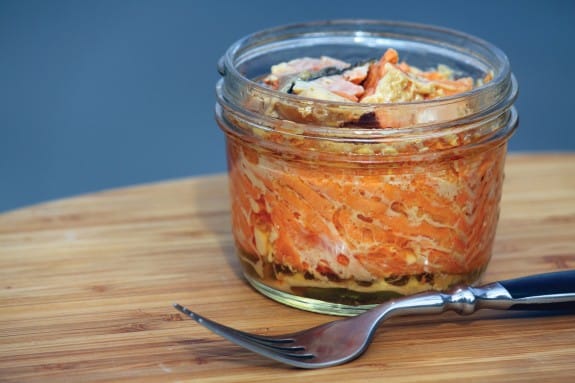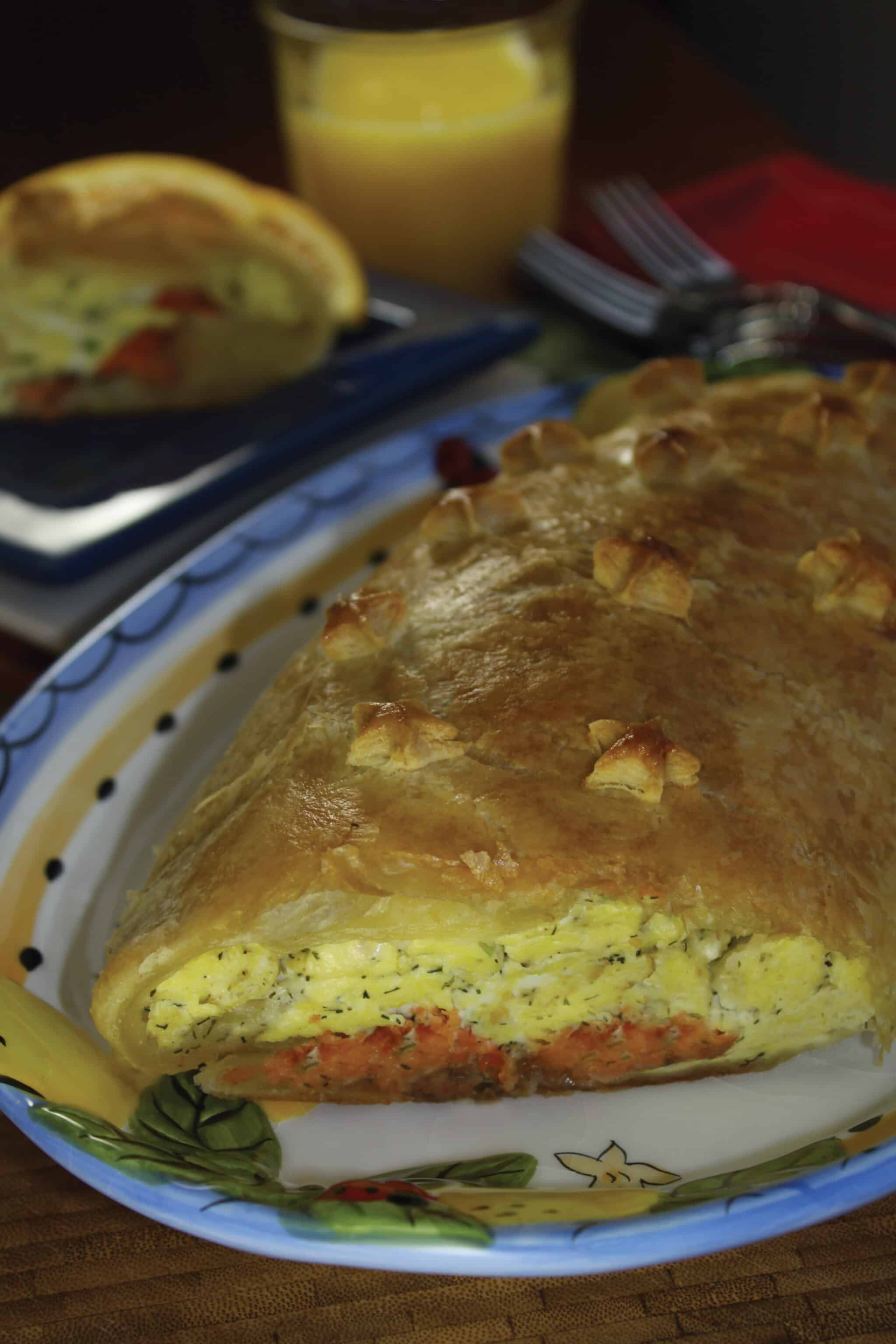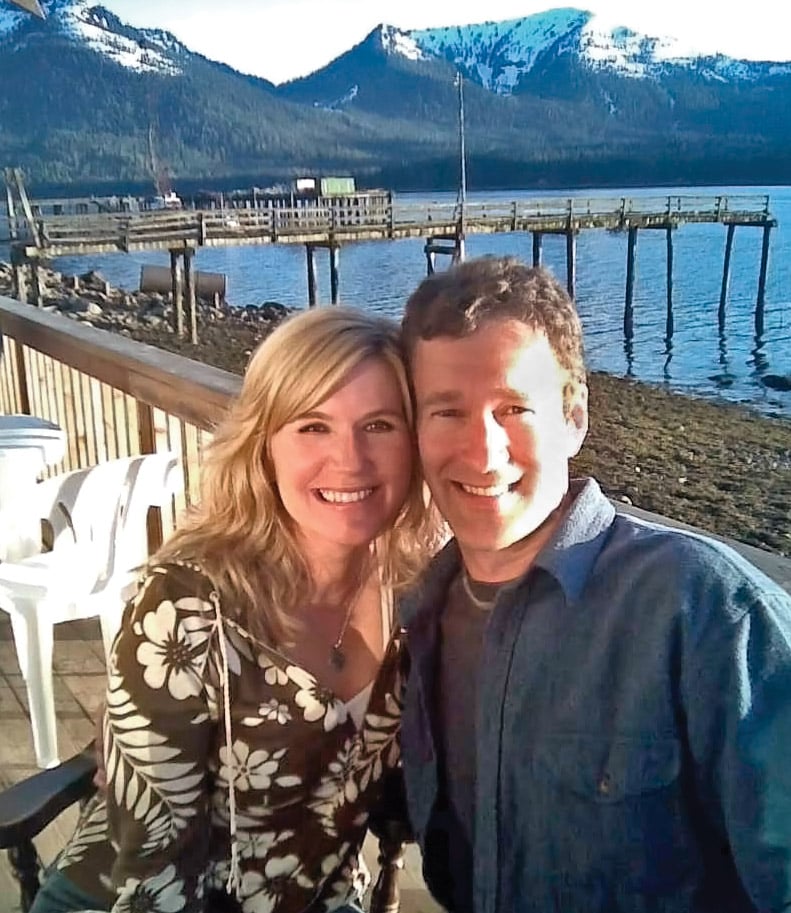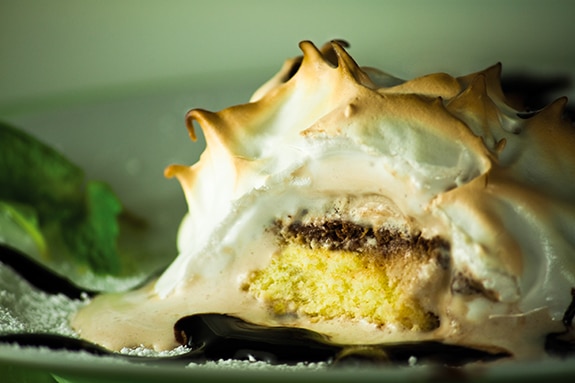I love this Apple Spiced Salmon recipe because of its unique flavor and ease of preparation. Continue Reading →
Apple Spiced Salmon
This recipe is from Salmon, Desserts & Friends
by LaDonna Rose on August 17, 2017 in Entrées, Recipes, Salmon Desserts & Friends

Baked Mediterranean Salmon Casserole
This recipe is from Salmon, Desserts & Friends
by LaDonna Rose on October 24, 2016 in Entrées, Recipes, Salmon Desserts & Friends

An enticing combination of salmon, egg noodles, garlic, portabella mushrooms and artichoke hearts. This Baked Mediterranean Salmon Casserole is the perfect weeknight recipe, that is a snap to prepare. Serve with crusty bread and a green salad. Continue Reading →
Wild About Salmon
This recipe is from Salmon, Desserts & Friends
by LaDonna Rose on February 9, 2016 in Breakfast, Recipes, Salmon Desserts & Friends

This recipe is dedicated to my Alaskan friends, who truly know what this picture represents. Continue Reading →
Alaska Seafood Sustainability
by LaDonna Rose on August 1, 2012 in Wild caught Alaska salmon
The sustainable movement is sweeping across the world, and more and more people are taking interest.
But what does all this talk about sustainability really mean?
And what does your choice for dinner have on the world around you?
To start, all you have to do is visit Alaska…The last frontier in sustainability.
If you’re like most people, you know Alaska for its snow-covered mountains, glaciers that date back millions of years, and the incredible green beauty in summertime. But the state is also the world model for sustainability – and maybe for government genius, too. That’s because Alaska is the only state with a mandate for sustainable seafood written right into its State Constitution.
All told, Alaska supplies more than half of the wild-caught seafood in the United States. And Alaska will always be home to the greatest salmon runs in the world, providing as much as 95 percent of North America’s wild salmon.
What is sustainable seafood? It’s seafood that’s managed and fished using practices that ensure there will always be more to catch in the future.
The secret to Alaska’s success lies in two basic principles:
* Responsible fisheries management and sustainable fishing practices take
care not to harm the fish, other marine plants and animals, nor the
environment.
* Fish populations are never overfished. Overfishing happens when too many
fish are taken from the sea and there are not enough fish to replenish the
natural population.
Alaska boasts in having one of the worlds few governments that is truly dedicated to sustainability. It’s a commitment that dates all the way back to Alaska becoming a state in 1959, when Alaskan wrote sustainability into their Constitution-calling for fisheries to be sustainably managed in this way, Alaska promises to provide wild-caught and sustainable seafood for generations to come.
What can you do to help. When it comes to selecting from a wide variety of healthy and delicious seafood options, Alaska has you covered. When you buy Alaska seafood, you are making a responsible and tasty choice that’s good for you-and supports sustainable seafood.
So next time you’re at your favorite restaurant or supermarket, be sure to ask your waiter or fishmonger where the seafood came from and how it was fished. Better yet, simply ask for Alaska, or look for the Alaska logo.

For more information on sustainable fishing practices and Alaska seafood, please visit www.alaskaseafood.org
Shelf Life of Canned Salmon
by LaDonna Rose on July 18, 2012 in Tips and Tricks
How do I determine how old my can of salmon is?
Look at the code that is either embossed onto the lid or printed onto the bottom of the can. The third digit in the top row of numbers and letters is the year it was canned. For example, 343TP would have been canned in 2003, 365TS would have been canned in 2005, etc. Some companies are now printing an expiration date on all products to make this process easier.
What is the shelf life of canned salmon?
Canned salmon is a very shelf-stable item. Quality will remain good for at least 6 years, however the actual shelf life can be much longer, provided that the integrity of the can is not compromised. The flavor may diminish after that length of storage time. Once you have opened the can make sure the leftovers are properly covered, refrigerated and consumed shortly after. Once opened canned salmon can be stored in a refrigerator for about three days if it has been properly wrapped. It is also possible to freeze canned salmon in a zip-lock or other type of freezer bag for consumption within a few months (just remember to dethaw it). As with most perishable food products canned salmon should not be left for long time periods at room temperature.
What species of salmon are canned? Why is Red Sockeye salmon more expensive than Pink, Chum and Coho Salmon? What are the differences between them?
Pink and Chum Salmon are available in greater numbers than Red Sockeye or Coho salmon, making them lesser in cost. Red Sockeye salmon is known for its deeper red color, firmer texture, and higher oil content. Coho or Silver salmon may also be known as Medium Red salmon. It is a softer texture than Red salmon and has a light medium red color. Pink Salmon is more delicately flavored and lighter in color. Chum salmon, also known as Keta salmon, is also lighter in color but usually has a firmer texture than Pink. All species are considered healthy sources of nutrition, such as Omega-3 fatty acids, and may be used interchangeably in most recipes.
How can I tell if my canned salmon is wild salmon or farmed salmon?
Most of the canned salmon found in supermarkets across North America is sourced from wild salmon fisheries. However, there are a few companies that may use farmed salmon in their cans. One of the best indicators of whether your salmon is sourced from the wild or from a fish farm is by looking at the labeling on the can. Many companies will indicate directly on the can that their salmon is wild caught. In addition, it may be helpful to know a little bit about the company and whether it has any corporate principles that prohibit them from using salmon caught from salmon farms. If the can is not properly labeled or vague you may want to pass. Alaska does not allow salmon farms, so when you see the lid that says “Alaska Salmon USA”, you can rest assured that these fish were not farm raised.
Why does canned salmon sometimes have glass looking crystals in it?
Every so often some people may find and be curious what the glass-like crystals are in canned salmon. These are called struvite crystals and might be mistaken by a consumer for a shard of glass. A variety of canned seafood products sometimes contain these naturally made crystals. Struvite crystals are formed after the salmon has been put in the can and are made of magnesium ammonium phosphate. They have a hardness compared to table salt and can be crushed into a powder with your finger. They dissolve in water and in your stomach.
What are Omega-3 Fatty Acids?
Omega-3 fatty acids are long chain fatty acids (DHA and EPA) that are known for their health benefits. The American Heart Association recommends eating at least 2 servings of fish a week to protect your heart, particularly fish that are known to contain high levels of Omega-3 fatty acids, such as salmon.
Canned salmon is an excellent source of Omega-3 fatty acids.
Our good friend Linda at Chinook and Company in Ketchikan is a wonderful source for canned salmon.
www.chinookandcompany.com
Gone Fishing
by LaDonna Rose on July 5, 2012 in 2012 Commercial Salmon Season
We are headed south to Tree Point to catch some red gold. Salmon that is. For the next two months I will fall off the World Wide Web. As of yet, there is no WiFi where we will be fishing. So you’ll have to manage without me. I have no doubt that you will do so fabulously. While I’m gone, thanks to Word Press there are four more automated weekly blog posts you can check out. Simply go to my website www.ladonnarose.com and click on FishTales. There’s a Candied Smoked Salmon recipe posting in two weeks. Be sure to check out The Recipe of the Week for a scrumptious recipe, if you haven’t already.
Here’s to everyone having a great summer! I’ll catch up with you when I return so we can trade stories again. Until then, “Fish On!”
Salmon and Wine are Simply Meant to Be Together
by LaDonna Rose on May 9, 2012 in salmon and wine
Salmon are perhaps the most visually striking of the world’s fish. Sleek and silvery, they are aquatic vertebrates of grace and beauty with buttery and succulent flesh. It’s no wonder that foodies have long considered salmon as one of the ocean’s great natural delicacies.
As its name implies, it’s neither red-fleshed nor white, making it an exceptionally accommodating wine companion. Depending on the preparation, salmon dishes can be paired with a spectrum of wines, including Champagne, Chardonnay and Pinot Noir.
I have been cooking salmon for 25 years and I must have 100 plus recipes for it in my head. While there are several factors that can affect what wine goes best with salmon, you can’t go wrong if you choose a bottle that stands up to the strong flavor of the fish without overpowering it.
Salmon, unlike most foods, has the uncanny ability to be matched to wine by texture — either complementary or in counterpoint — as well as by its saucing.
Salmon also lends itself to assertive adornments. Bright, acidic sauces – those made with lemon, capers, tomatoes and fruit – work well because they cut through some of the fish’s inherent richness. Salmon’s luxuriant qualities can be heightened with marinades and sauces that include brown sugar, soy sauce, ginger, garlic, hot peppers and sesame oil that enhances salmon without overwhelming its intrinsic flavor. Cooking methods broaden its range – it can be served smoked, poached, grilled, steamed or baked, the list of possibilities for salmon is quite long.
Personal Preference
Wine pairings are also a matter of personal preference. While a certain white wine may be best suited to your meal, you may prefer to drink red wines. Your taste preferences are just as important as any other factor.
If you like your everyday red or white wine, don’t worry about trying to match the food you are eating with that particular wine. What matters most is that you like how your wine tastes. Not every meal requires the perfect match with a wine. With a little research, you can find a wine you love that is perfect for your meal.
Wine Recommendations for Salmon
Depending on the flavors of your meal, one of these wines could be an excellent choice:
Chardonnay Pair this richer white wine with buttered salmon. Chardonnay is a full-bodied wine that is full of flavor. A plain white fish would be completely overshadowed by this powerful white wine, but when served with buttered salmon, the Chardonnay only further complements the creamy flavor of the fish, making it one of the best wine pairings for salmon.
Riesling ths crisp, acidic wine pairs best with the richer flavor of salmon. A good Riesling will also give off a citrus lime flavor that complements salmon. It also pairs well with spicier cuisine, so if you want to try cooking up a more exotic-flavored salmon recipe you might want to pair the concoction with a glass of Riesling.
Pinot Grigio is wonderful with most seafood, including salmon. This light white wine is best with salmon that doesn’t have a strong sauce, and it is excellent with lemon-based sauces. This white wine carries a more succulent flavor like the Riesling with hints of pear and peach. Pinot Grigio is a full-bodied wine that could overpower white fish or shellfish but pairs very well with salmon, particularly smoked salmon. It also goes well with various side dishes.
Sauvignon Blanc is also a great white wine for lighter salmon dishes. It’s important to choose a bottle that is not too fruity. This wine goes well with a number of different entrees, since it is light, refreshing and a bit acidic. The combined aromas of Sauvignon Blanc can bring out the taste of lemon-flavored salmon quite well. It also pairs well with sushi.
Pinot Noir is a great choice if you love red wine. It’s especially excellent with salmon prepared on the grill, and it can hold up to the strong flavor of this fish. This is one of the lighter red wines, so it pairs extremely well with foods like salmon. It is often too heavy for white fish and too light for red meat, but salmon finds the perfect balance when paired with this wine. A Pinot Noir served with herb-grilled salmon will taste especially flavorful.
Zinfandel is very good with blackened or grilled salmon. Look for a bottle that is somewhat fruity and not too dry. This medium-bodied wine displays classic varietal character with a fresh berry aroma and a hint of black pepper. The flavors are bright and juicy, with a zesty spiciness. Pairs beautifully with salmon.
Too often wine can intimidate us. Part of this is due to the tremendous number of choices that exist and part of it is due to the tendency to make wine too precious.
Wine is meant to be enjoyed with food.
Hopefully the above will be useful to you as a guide. It comes down your own choice and preferences. Drink what you like, it’s part of the joy of pairing food and wine!
Cheers!
What type of wine do you serve with Alaskan salmon?
7 Reasons To Ask For Alaska Seafood
by LaDonna Rose on April 25, 2012 in 7 Reasons to ask for Alaska Seafood
WILD – Alaska seafood is wild caught! There is no finfish farming allowed in Alaska. The seafood is harvested in the wild, in the pristine waters off Alaska’s rugged 34,000 mile coastline.
NATURAL – Alaska Seafood is seafood at its natural best. Alaska boasts five species of salmon, shrimp, scallops, crab, and whitefish varieties that include pollock, halibut, Pacific cod, black cod, sole, and rockfish. They mature at a natural pace, swimming freely in the icy cold waters and eating a natural diet of marine organisms.
SUSTAINABLE – Alaska’s seafood is eco-friendly. Alaska’s abundant seafood species are part of healthy, intact ecosystems, and the fisheries are managed for sustainability. Ever since statehood in 1959, Alaska’s fisheries have been managed with the long term health of the stocks as top priority. This is mandated by the Constitution of the State of Alaska. Alaska’s healthy marine environment and sustainable fisheries management are a model for the world.
FLAVOR – The superior flavor and texture of Alaska seafood is prized around the world. They get their flavor and flesh color from their natural diet of marine organisms: in the case of salmon this includes krill and tiny crustaceans. Salmon migrate thousands of miles over the course of their lifetime, and all that exercise in cold water gives the fish a firm texture. Each of the five species – pink, keta, sockeye, coho, and king – has its own characteristics of color and flavor.
VERSATILE – Alaska seafood is easy to prepare. You can grill, poach, bake, sauté, and even take portions right from the freezer for cooking, putting a meal on the table in minutes.
HEALTHY – Alaska seafood is healthy and nutritious. It is high in protein, and low in saturated fat, and a natural source of the “good fats” – heart-healthy omega-3s.
U.S. JOBS for a HEALTHY ECONOMY – Over half the seafood harvested by American fishing families is harvested in the waters off Alaska. Although many of the families fish from small vessels, and the seafood is usually processed in small communities, the Alaska seafood industry is a major economic engine: it is Alaska’s largest private sector employer, providing work for 54,000 people, and worth an estimated $5.8 billion to Alaska in direct and induced economic output.
Please visit www.alaskaseafood.org for more interesting and important nutritional information, recipes and to learn more about Alaska seafood.
Youthful Skin–Naturally with wild Alaskan salmon
by LaDonna Rose on April 4, 2012 in Youthful Skin--Naturally with wild Alaskan salmon

According to Dr. Nicholas Perricone “There is a little beauty secret that is worth it’s weight in gold. If women understood that eating a simple inexpensive small can of salmon would give them radiant skin, with softness like nothing else in this world, salmon would fly off of the supermarket shelves”.
You would see a stampede toward the fish isle.
Sounds like a fantasy? I assure you it is very real…
Why salmon makes you youthful
Salmon is one of the best-known sources of skin-beautifying Omega fatty acids. Salmon reduces inflammation more effectively than any other food. It enhances radiance, reduces wrinkles and puffiness. Salmon is a beauty food because it’s nutrients play a key role in keeping the skin’s outer layer soft and smooth. The Omega-3s in salmon reduce inflammation on the cellular level that can cause redness, wrinkles, and loss of firmness.
Ever wonder what salmon, shrimp and lobster have in common? Their brilliant red color is a result of Astaxanthin, the multi-talented antioxidant. Astaxanthin is the super star in the realm of anti-aging. What it does is protects the cells from the most damaging forms of free radicals-improves skin elasticity and reduces the appearance of fine lines. Astaxanthin is available as a nutritional supplement and worth looking into.
There’s another super star substance found in wild Alaskan salmon and that is DMAE. DMAE is a known cognitive enhancer–that is, that it can improve memory and problem-solving ability. It does so because it improves nerve function. DMAE when eaten in larger amounts, can increase muscle tone and therefore decrease the appearance of sagging. As a side note, DMAE can be placed into a lotion form and applied topically to help decrease sagging and increase muscle tone.
According to the Perricone Diet, our skin can get immediate benefits by following what he calls a nutritional facelift for three days. The foundation of this diet is wild salmon, eaten twice a day with blueberries, cranberries, raspberries and strawberries. The Wrinkle Cure by Dr. Nicholas Perricone is worth the read.
Here’s five ideas to incorporate wild Alaskan salmon into your diet.

1. Shop for wild Alaskan salmon when it’s in season. You’ll feel good knowing that you are not only getting the freshest salmon available, but you are also supporting a commercial fishing family.

2. Prepare your salmon simply. Try using Olive oil and Lemon pepper for a tasty glaze without added fat.

3. Eat it for breakfast. You wouldn’t think of eating salmon in the morning with a bagel and fresh blueberries, but it works!

4. Make eating salmon a healthy social event. Make a date to go to the Fishermen’s Market, or bring out the BBQ for a potluck dinner.

5. Get creative. You could put in your eggs in the morning, toss it in your salad at lunchtime, make it into a sandwich, put it on your pasta, broiled as a burger, baked in the oven, or thrown on the grill.

There are so many different things you can do with salmon that it becomes far easier to make it part of your normal diet. When I tell people I eat salmon 5 times a week sometimes twice a day, the response is “Why so much?” Because eating wild Alaskan salmon one or two times a day, will do more for your skin than any other anti-aging remedy that I know of.
While I can’t promise you can turn back time, the anti-inflammatory benefits of foods such as salmon, will gaurantee that you can greatly slow down it’s negative effects. These include good health, ample energy, increased sense of well-being and radiant, glowing skin.
In other words, there are many health benefits to be had from eating wild Alaskan salmon.
Know of any other foods that are great for the skin? I’d love to know what they are.
Best Fishes! LaDonna Rose
Has This Ever Happened To You?
by LaDonna Rose on March 26, 2012 in Has this ever happened to you?
I had a very nice, friendly, positive, uplifting blog planned for today. Something came up this weekend that I feel I have to address while it’s fresh on my mind.
Has This Ever Happened To You?
You plan a trip to the big city for some shopping, eating out and entertainment.
You’re not sure what your exited for… Trader Joe’s, Target, Tj Max, Victoria Secret or the romantic dinner at your favorite restaurant with your lover or just plain getting out of town.
You plan this say, two weeks or more in advance. For me this last weekend, it was dinner at one of our favorite restaurants in Eugene, The Lucky Noodle.
For me this last weekend, it was dinner at one of our favorite restaurants in Eugene, The Lucky Noodle.
We were especially excited because we hadn’t been to this restaurant in nearly three years. This place has it all… atmosphere, food, service, we have never been disappointed. We knew we wanted to enjoy the evening, so we booked a room at the newly opened Inn at 5th Street to spend the night. It’s less than a block away, which made it even more enjoyable strolling along 5th Street Market hand in hand.  We arrive at the restaurant. We were seated, the server hands us our menus and I’m pleased to see Fresh Alaskan Salmon listed for two of their entrees.
We arrive at the restaurant. We were seated, the server hands us our menus and I’m pleased to see Fresh Alaskan Salmon listed for two of their entrees.
What first went through my mind is fresh… hummm… it’s March… so it must be frozen. That’s okay. Ordinarily I’m very cautious to order salmon in a restaurant unless I’m absolutely sure it’s wild. Naturally, I ask our server if she was positive the salmon is wild from Alaska? She said yes, it is wild from Alaska.
Now keep in mind this is one of our all time favorite restaurants. So the thought of them Pan Roasting wild Alaskan salmon and finishing it with beurre blanc, served with house made asparagus risotto was too much to resist!
Over two Blueberry Cosmos, we waited for our dinner talking about the beautiful day we had, our wonderful room, the coming salmon season in Alaska and soaking up the wonderful atmosphere.
Our entrees arrived it looked so good I even took a picture of it!  With excitement I dove in! Now obviously I know my salmon, but I couldn’t quite put my finger on what species it was so Ole tried a piece. Hesitantly his guess was Coho, then said it was a bit like wet partial board. I tried another piece and had another one ready to go on the fork, when a server clearing a nearby table nicely asked how is your salmon? I say great, I think…say, what type of salmon am I eating? Wild Alaska, he says, I say no, what type? Coho, Sockeye, King? He said let me go back to the kitchen and check.
With excitement I dove in! Now obviously I know my salmon, but I couldn’t quite put my finger on what species it was so Ole tried a piece. Hesitantly his guess was Coho, then said it was a bit like wet partial board. I tried another piece and had another one ready to go on the fork, when a server clearing a nearby table nicely asked how is your salmon? I say great, I think…say, what type of salmon am I eating? Wild Alaska, he says, I say no, what type? Coho, Sockeye, King? He said let me go back to the kitchen and check.
Has This Ever Happened To You?
Waiting for the verdict, I chose to only eat the delicious risotto.
The server comes back and happily announces that wild Alaska salmon is not in season and instead of serving frozen salmon we substitute farm-raised salmon.
Now…those of you that know me really really well, what do you think I did?
A. Drop my fork?
B. Said it’s FARMED?!?!?!?!?!?!?
C. Picked up my plate and tossed it to the middle of the table?
Or
D. All of the above?
The answer is D all of the above and that was just the beginning.
Has This Ever Happened To You?
Ole pushed his plate away also and we just stared at each other in disbelief of what we just heard.
I told our server that the restaurant is advertising Fresh Alaskan salmon and you are serving farmed salmon, this is false advertising! My blood pressure went through the roof trying to explain to her how rotten farmed-raised salmon is for the environment and for people’s health. I said unknowingly, I just ingested red dye, which is showing up in people’s retinas, antibiotics, chemicals, pesticides and who know’s what else.
She was very apologetic and said since our evening was virtually ruined she would comp our entire meal.
Has This Ever Happened To You?
While still at our table preparing to go, we decided to see a manager to clear this up even further. A woman who works in the restaurant comes over to our table and says… I hear you are threatening to sue our establishment. I tell her what I did say and that is you are advertising Fresh Alaskan salmon for $24.00 a plate and serving cheap inexpensive farmed-raised salmon that potentially could make people sick from an allergic reaction. If I was to turn you into the Attorney General for false advertising I believe it is a hefty fine.
She said, our supplier assures us that farmed-raised salmon is good to eat and there’s nothing wrong with it. I told her several times that’s not the point. The point is, The Lucky Noodle is using Alaska’s quality name to promote an inferior product, which is ethically wrong and hurts Alaska’s reputation.
She made some reference to Farmed Alaska salmon. OMG!!! We kept telling her over and over that there are no fish farms of any type in the state of Alaska.
The woman continued arguing with us… and then she said… she would only comp my meal and we would have to pay for all the rest.
What do you think Ole did?
A. Stood up and put his coat on?
B. Told the woman we are salmon fisherman from Alaska and we know what we are talking about?
C. You completely ruin our evening and you want us to pay for this experience?
D. All of the above?
Yep! D.
She disappeared and so did we.
Has This Ever Happened To You?
The moral to this story: We will never go back to the Lucky Noodle, because our thoughts are; if they are deceiving us about this, what else are they being deceptive about and cutting corners on? The most upsetting thing is they are using Alaska’s good name on their menu to hoodwink people into thinking they’re getting top quality, when in fact they’re getting the bottom end of quality. When did The Lucky Noodle stop serving wild Alaska Salmon even though it is still printed on their menu? Back in September 2011 when the wild salmon season closed?
When dining out unless you know the owner, manager or server very well, ask your server to go back to the kitchen and ask what type of salmon it is and where did it come from. Consumers can ask their server what region the salmon is from, what species it is and is it fresh or frozen.

They should be able to answer or find someone to answer, if they can’t, then you may want to take your business elsewhere.
I was fooled…and if I can be fooled…anybody can.
Has This Ever Happened To You? You ordered something from the menu and you were brought something completely different? Ever had a server argue with you?
Best Fishes! LaDonna Rose
Because I believe everyone should do their own research, below are a few links to get you started.
Salmon served in some Puget Sound restaurants often mislabeled
Oregon Deceptive Trade Practices Laws

About LaDonna
I’m LaDonna Rose Gundersen, Alaskan fisherwoman, cookbook author and lover of salmon. The recipes and tales I share are inspired by life aboard the LaDonna Rose – the fishing boat my husband Ole and I operate together out of Ketchikan, Alaska. Read more... Follow me Facebook
Follow me Facebook
 Follow me Instagram
Follow me Instagram
 Follow me Pinterest
Follow me Pinterest


















